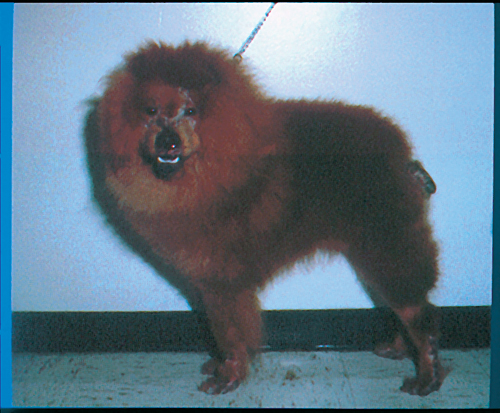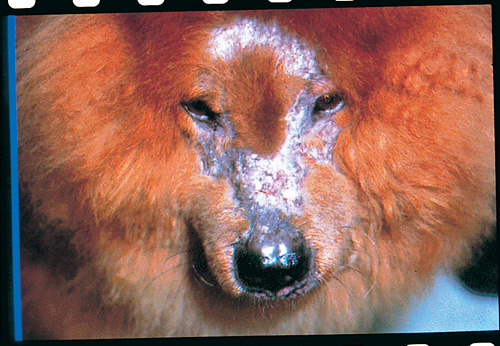Difference between revisions of "Small Animal Orthopaedics Q&A 05"
| Line 16: | Line 16: | ||
|a1= | |a1= | ||
Dermatomyositis, which has been observed in Collies, Shetland Sheepdogs, Chow Chows, a Pembroke Welsh Corgi and an Australian cattle dog. This disease has an autosomal dominant mode of inheritance in Collies, but the pattern of inheritance has not yet been established in other breeds. | Dermatomyositis, which has been observed in Collies, Shetland Sheepdogs, Chow Chows, a Pembroke Welsh Corgi and an Australian cattle dog. This disease has an autosomal dominant mode of inheritance in Collies, but the pattern of inheritance has not yet been established in other breeds. | ||
| − | |l1= | + | |l1=Canine Dermatomyositis |
|q2=What diagnostic tests should be considered to confirm the diagnosis? | |q2=What diagnostic tests should be considered to confirm the diagnosis? | ||
|a2= | |a2= | ||
| Line 26: | Line 26: | ||
Fibrillation potentials, positive sharp waves, and bizarre high frequency discharges should be present on EMG of muscles of the head, trunk and extremities of affected dogs. | Fibrillation potentials, positive sharp waves, and bizarre high frequency discharges should be present on EMG of muscles of the head, trunk and extremities of affected dogs. | ||
| − | |l2= | + | |l2=Canine Dermatomyositis#Diagnosis |
|q3=Assuming the diagnosis is correct, what is the prognosis? | |q3=Assuming the diagnosis is correct, what is the prognosis? | ||
|a3= | |a3= | ||
| Line 38: | Line 38: | ||
Therapy with vitamin E, corticosteroids and pentoxifylline has provided variable results. | Therapy with vitamin E, corticosteroids and pentoxifylline has provided variable results. | ||
| − | |l3= | + | |l3=Canine Dermatomyositis#Treatment |
</FlashCard> | </FlashCard> | ||
Latest revision as of 16:00, 24 October 2011
| This question was provided by Manson Publishing as part of the OVAL Project. See more Small Animal Orthopaedics Q&A. |
Photographs of a one-year-old, male Chow Chow with multifocal scarring alopecia; hyperpigmentation and ulceration of the face, tail tip and distal extremities; and a stiff gait in all four limbs. There is muscle atrophy of the temporal and triceps muscles. The dog’s skin lesions have been present since six months of age.
| Question | Answer | Article | |
| What is the most likely diagnosis? | Dermatomyositis, which has been observed in Collies, Shetland Sheepdogs, Chow Chows, a Pembroke Welsh Corgi and an Australian cattle dog. This disease has an autosomal dominant mode of inheritance in Collies, but the pattern of inheritance has not yet been established in other breeds. |
Link to Article | |
| What diagnostic tests should be considered to confirm the diagnosis? | The diagnosis is made based on clinical signs, histologic evaluation of affected muscles and skin, and EMG. Skin lesions usually occur in young dogs; however, skin lesions may be so mild that they are missed at an early age. A skin biopsy of an alopecic, scarred lesion is preferred. Evidence of myositis is present on histologic evaluation of muscle. Fibrillation potentials, positive sharp waves, and bizarre high frequency discharges should be present on EMG of muscles of the head, trunk and extremities of affected dogs. |
Link to Article | |
| Assuming the diagnosis is correct, what is the prognosis? | Disease severity varies widely in dogs with dermatomyositis, making prognosis difficult to predict and therapeutic trials difficult to evaluate. The disease often waxes and wanes of its own accord. Skin lesions of mildly affected dogs may heal without scarring and the dogs may live normal lives. Moderately affected dogs may have cutaneous scarring and some muscle atrophy. More severely affected dogs have persistent skin and muscle disease with stunted growth. Secondary pyoderma, demodicosis and aspiration pneumonia from involvement of esophageal muscles are potential problems in severely affected dogs. Therapy with vitamin E, corticosteroids and pentoxifylline has provided variable results. |
Link to Article | |

